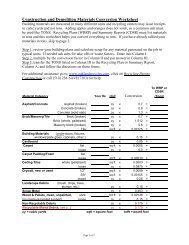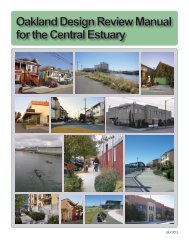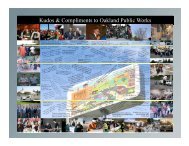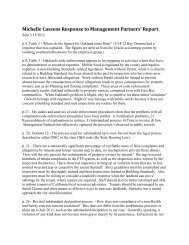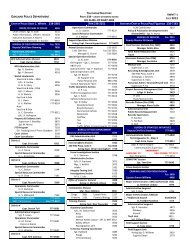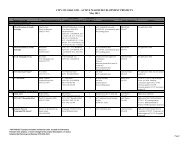Intelligent Transportation Systems - City of Oakland
Intelligent Transportation Systems - City of Oakland
Intelligent Transportation Systems - City of Oakland
Create successful ePaper yourself
Turn your PDF publications into a flip-book with our unique Google optimized e-Paper software.
This same hardwire configuration can be used for other low bandwidth devices such as<br />
DMS, TBS and VDS, if desired.<br />
6.6.2 High Bandwidth Devices<br />
High bandwidth devices require a higher speed connection and can generally utilize fiber<br />
optics, microwave or leased lines such as DSL, T1-T3. The two high bandwidth devices<br />
being recommended in this Strategic Plan are CCTV cameras and kiosks.<br />
When using fiber for CCTV communication, one fiber strand is required from the<br />
backbone to connect to each CCTV camera. This single fiber strand is used to transmit<br />
video in one direction and PTZ data in both directions. However, due to the high<br />
bandwidth requirements <strong>of</strong> CCTV, the devices must be configured in a point-to-point<br />
topology (see Figure 6-1). In this configuration, one fiber strand is dedicated to each<br />
CCTV camera.<br />
6.7 COMMUNICATIONS NETWORK RECOMMENDATIONS<br />
This section introduces short-, medium-, and long-term communications to deliver the<br />
needs <strong>of</strong> the <strong>City</strong> into the 21 st century. The main considerations for communications are<br />
derived from the need for low and high-speed connections. High bandwidth ITS<br />
elements such as CCTV will utilize fiber optics. Some <strong>of</strong> the low bandwidth ITS<br />
elements will utilize existing conduit and TWP when it is more cost effective than<br />
upgrading to fiber. TWP can be tied directly into the TMC or into field communications<br />
hubs where it is connected to the <strong>City</strong>’s fiber backbone. Conduit and fiber infrastructure<br />
should be built on the priority corridors mentioned in Section 2. The fiber cable should<br />
be sized to accommodate future communications needs. At a minimum, a 96-strand<br />
fiber cable is recommended on each priority corridor. In the remote areas <strong>of</strong> <strong>Oakland</strong>,<br />
where building conduit infrastructure may be costly, CDPD wireless modems or 2.5 GHz<br />
Spread Spectrum (802.11 A/B) would be cost effective solutions to transmit data back to<br />
the TMC. A top-level phased approach to the communications requirements is provided<br />
below.<br />
6.7.1 Short-Term Communications Plan (0 to 5 years)<br />
In the short-term plan the focus should be on the Airport/Coliseum area and some <strong>of</strong> the<br />
high priority corridors (see Section 8 for specifics). The high priority corridors near<br />
downtown such as Broadway and Telegraph should be tied directly into the TMC. The<br />
high priority corridors near the Airport/Coliseum area should be connected to the MSY<br />
communications hub. From the MSY, a leased T-1 line should be utilized to provide a<br />
high-speed connection to the TMC for the near term. This T-1 line should be dedicated<br />
to the <strong>Transportation</strong> Services Division and be used for traffic management purposes<br />
only.<br />
CCTV cameras should utilize a fiber network installed in existing or new conduits.<br />
Traffic signals should utilize existing TWP interconnect, if available. If no TWP<br />
interconnect exists, fiber could be used to interconnect signals and transmit CCTV<br />
images. All other low speed ITS elements such as DMS and VDS should utilize wireless<br />
connections or phone drops. Based on the actual deployment and commissioning<br />
schedule <strong>of</strong> the <strong>City</strong>’s ITS projects, the best wireless network and service plan should be<br />
<strong>City</strong> <strong>of</strong> <strong>Oakland</strong> ITS Strategic Plan<br />
77 September, 2003







